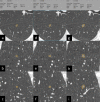Pulmonary quantitative CT imaging in focal and diffuse disease: current research and clinical applications
- PMID: 29172671
- PMCID: PMC5965469
- DOI: 10.1259/bjr.20170644
Pulmonary quantitative CT imaging in focal and diffuse disease: current research and clinical applications
Abstract
The frenetic development of imaging technology-both hardware and software-provides exceptional potential for investigation of the lung. In the last two decades, CT was exploited for detailed characterization of pulmonary structures and description of respiratory disease. The introduction of volumetric acquisition allowed increasingly sophisticated analysis of CT data by means of computerized algorithm, namely quantitative CT (QCT). Hundreds of thousands of CTs have been analysed for characterization of focal and diffuse disease of the lung. Several QCT metrics were developed and tested against clinical, functional and prognostic descriptors. Computer-aided detection of nodules, textural analysis of focal lesions, densitometric analysis and airway segmentation in obstructive pulmonary disease and textural analysis in interstitial lung disease are the major chapters of this discipline. The validation of QCT metrics for specific clinical and investigational needs prompted the translation of such metrics from research field to patient care. The present review summarizes the state of the art of QCT in both focal and diffuse lung disease, including a dedicated discussion about application of QCT metrics as parameters for clinical care and outcomes in clinical trials.
Figures






Similar articles
-
Development of quantitative computed tomography lung protocols.J Thorac Imaging. 2013 Sep;28(5):266-71. doi: 10.1097/RTI.0b013e31829f6796. J Thorac Imaging. 2013. PMID: 23934142 Free PMC article. Review.
-
A Computer-based Analysis for Identification and Quantification of Small Airway Disease in Lung Computed Tomography Images: A Comprehensive Review for Radiologists.J Thorac Imaging. 2023 Jan 1;38(1):W1-W18. doi: 10.1097/RTI.0000000000000683. Epub 2022 Oct 10. J Thorac Imaging. 2023. PMID: 36206107 Review.
-
Computer-aided diagnosis in lung nodule assessment.J Thorac Imaging. 2008 May;23(2):97-104. doi: 10.1097/RTI.0b013e318173dd1f. J Thorac Imaging. 2008. PMID: 18520567 Review.
-
Illustration of the obstacles in computerized lung segmentation using examples.Med Phys. 2012 Aug;39(8):4984-91. doi: 10.1118/1.4737023. Med Phys. 2012. PMID: 22894423 Free PMC article.
-
The Modern Art of Reading Computed Tomography Images of the Lungs: Quantitative CT.Respiration. 2018;95(1):8-17. doi: 10.1159/000480435. Epub 2017 Sep 16. Respiration. 2018. PMID: 28918422
Cited by
-
The radiological appearances of lung cancer treated with immunotherapy.Br J Radiol. 2023 Mar 1;96(1144):20210270. doi: 10.1259/bjr.20210270. Epub 2022 Dec 19. Br J Radiol. 2023. PMID: 36367539 Free PMC article. Review.
-
Spread through air spaces in lung adenocarcinoma: is radiology reliable yet?J Thorac Dis. 2019 Mar;11(Suppl 3):S256-S261. doi: 10.21037/jtd.2019.01.96. J Thorac Dis. 2019. PMID: 30997191 Free PMC article. No abstract available.
-
Diagnosis and management of lung involvement in systemic lupus erythematosus and Sjögren's syndrome: a literature review.Ther Adv Musculoskelet Dis. 2021 Sep 30;13:1759720X211040696. doi: 10.1177/1759720X211040696. eCollection 2021. Ther Adv Musculoskelet Dis. 2021. PMID: 34616495 Free PMC article. Review.
-
Pulmonary Hypertension in Association with Lung Disease: Quantitative CT and Artificial Intelligence to the Rescue? State-of-the-Art Review.Diagnostics (Basel). 2021 Apr 9;11(4):679. doi: 10.3390/diagnostics11040679. Diagnostics (Basel). 2021. PMID: 33918838 Free PMC article. Review.
-
Solid Indeterminate Pulmonary Nodules of Less Than 300 mm3: Application of Different Volume Doubling Time Cut-offs in Clinical Practice.Diagnostics (Basel). 2019 Jun 20;9(2):62. doi: 10.3390/diagnostics9020062. Diagnostics (Basel). 2019. PMID: 31226780 Free PMC article.
References
-
- Goldin JG. Computed tomography as a biomarker in clinical trials imaging. J Thorac Imaging 2013; 28: 291–7. doi: https://doi.org/10.1097/RTI.0b013e3182a1d93d - DOI - PubMed
-
- Hansell DM, Goldin JG, King TE, Lynch DA, Richeldi L, Wells AU. CT staging and monitoring of fibrotic interstitial lung diseases in clinical practice and treatment trials: a position paper from the Fleischner Society. Lancet Respir Med 2015; 3: 483–96. doi: https://doi.org/10.1016/S2213-2600(15)00096-X - DOI - PubMed
-
- Al Mohammad B, Brennan PC, Mello-Thoms C. A review of lung cancer screening and the role of computer-aided detection. Clin Radiol 2017; 72. doi: https://doi.org/10.1016/j.crad.2017.01.002 - DOI - PubMed
-
- Labaki WW, Martinez CH, Martinez FJ, Galbán CJ, Ross BD, Washko GR, et al. The role of chest computed tomography in the evaluation and management of the patient with COPD. Am J Respir Crit Care Med 2017. doi: https://doi.org/10.1164/rccm.201703-0451PP - DOI - PMC - PubMed
-
- Brown MS, Lo P, Goldin JG, Barnoy E, Kim GH, McNitt-Gray MF, et al. Toward clinically usable CAD for lung cancer screening with computed tomography. Eur Radiol 2014; 24: 2719–28. doi: https://doi.org/10.1007/s00330-014-3329-0 - DOI - PubMed
Publication types
MeSH terms
LinkOut - more resources
Full Text Sources
Other Literature Sources
Medical
Research Materials

